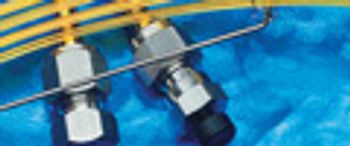
Although liquid chromatography (LC) is most commonly associated with analytical techniques that are found inside the laboratory, LC also has been used in industrial applications for separation of a wide range of products for decades.


Although liquid chromatography (LC) is most commonly associated with analytical techniques that are found inside the laboratory, LC also has been used in industrial applications for separation of a wide range of products for decades.

Chiral technology has become a very important aspect for scientists involved in the pharmaceutical, chemical, and agricultural industries. The chiral enantiomers can have vitally different pharmacological effects in biological systems. In fact, the U.S. Food and Drug Administration mandates that only therapeutically active isomers must be introduced to the prescription drug market.

Peptide mapping is one of the preferred techniques for the comprehensive characterization of biopharmaceutical products and is often the analytical method of choice for studying a protein's primary structure.

In 1983, the brainchild of Ed Aster, President of Aster Publishing, and Tom Hager, an editor, a publication called LC-Liquid Chromatography and HPLC Magazine was christened.

The terms hydrophilic interaction liquid chromatography (HILIC) and aqueous normal phase (ANP) chromatography very often are used interchangeably.

I have to cede my seniority as an LCGC columnist to Ron Majors - he started several months before I did.

Over the years, LC instrumentation has undergone continuous development in pursuit of greater performance. More recently, the focus of progress has been on shorter run times, as a direct response to greater user demand to perform faster chromatographic analyses, particularly for their LC–MS applications. This has led to separations on short (30–50 mm) columns with a small internal diameter (i.d. ~2.0 mm), packed with small particle size phases (1.5–3.0 μm). The trend for smaller column particle size has now reached a practical limit on current hardware and innovative technological solutions for further gains in performance are required. Several manufacturers offer fast LC instruments designed for greater productivity, while maintaining low carryover, high sample capacity, resolution and reliability. With ultra-fast run times of under 1 minute, these companies have achieved increased throughput using contrasting technological approaches. Here we examine the background to this current trend,..

Is it more than meets the eye?

...it is important to acknowledge that environmental concerns can be more important than the economics of the reduction of solvent consumption.

This month's forum looks at the topic of liquid chromatography-mass spectroscopy and the trends and issues surrounding it. Ed Long, Strategic Marketing Manager at Thermo Fisher Scientific, Robert Cody, Mass Spec Product Manager at JEOL, and Michael Willett, PR Relations Officer at Bruker.

Evaporative light scattering detection (ELSD) is considered by many to be a universal detection method for HPLC because its response does not depend on the analyte containing a chromophoric moiety.

Detector selection for a method should be made on a case-by-case basis.

his article reveals the first liquid chromatography (LC) separations performed on a microfabricated pillar array column under pressure-driven conditions. The pillars were non-porous and produced using a Bosch-type deep reactive ion etch (DRIE) to pattern the surface of a silicon wafer and had a diameter of approximately 5 μm. Two different packing densities were compared: one similar to the packing density of a packed bed (external porosity of approximately 49%) and one similar to the packing density of monolithic columns (external porosity of approximately 70%).

LC-MS-MS has become a widely used technique for the fast and sensitive quantitation of small molecules. In this article, this approach has been extended to high-throughput quantitative LC-MS-MS analysis under GLP applications for a drug candidate in development from preclinical animal studies through clinical development.

Prompted by a recently reviewed manuscript and a question from a reader, John Dolan examines the variability of retention times observed in LC methods in this month's installment of "LC Troubleshooting."

Guest columnist Volker Schurig discusses the achievements of Emanuel Gil-Av in introducing enantioselectivity into chromatographic analysis.

This month's installment of "Column Watch" is the conclusion of a two-part series in which columnist Ron Majors examines trends in column and sample prep introductions at Pittcon 2007.

Chiral technology has become a very important aspect for scientists involved in the pharmaceutical, chemical, and agricultural industry.

The major advantages of monolithic phases are their ability to withstand high mobile phase flow rates and the rapid separations at low back pressure that can be achieved with their use.

The continual increase in sample numbers in busy labs means that it is often difficult for quality control or contract analysis labs to maintain short turnaround times, particularly when instruments are already running at full capacity. To address the need for faster analysis while retaining the quality of separation offered by dedicated amino acid analysers, an improved formulation of sodium citrate based buffers has been developed by Biochrom.

it has been more than 10 years since solvent recycling has been the main subject of an "LC troubleshooting" column, so this month, John Dolan revists this subject.

Fast, reliable measurements of lipophilicity has a great impact on the compounds' selection process at an early stage of dug discovery. The guest columnit examines HPLC methods for this purpose.

Separation instrument techniques are among the most widely used technologies in the analytical instrumentation market. They span the entire industrial and regional marketplace. The lab separations market includes chromatographic techniques such as analytical and preparative HPLC, GC, IC, TLC, flash, and low pressure LC.

Research group: Professor Jan Andersson, Institute of Inorganic and Analytical Chemistry, University of Münster, Münster.

An overview is presented of possible pathways to enhance peak capacity in liquid chromatography (LC). The peak capacity in a chromatographic separation is directly related to the plate number and thus to column length and particle size. Serial coupled columns can be used to obtain long effective column lengths, reaching over 100000 theoretical plates and peak capacities up to 900. Some theoretical considerations are made on column dimensions and particle size and examples are given of high resolution "GC-like" separations in LC using state-of-the-art LC hardware. Recent developments in LC hardware have also enhanced the applicability of two-dimensional LC–LC and comprehensive LCÃ-LC. Both techniques are extremely powerful to unravel complex samples.